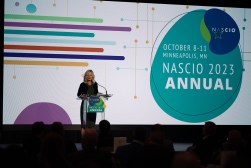Many states still lack plans for app modernization, NASCIO says

Despite state governments continuing to use a great number of outdated applications, many still lack documented plans to modernize them, according a new survey of state and territorial chief information officers.
In survey results published Wednesday by the National Association of State Chief Information Officers and VMware, nearly half of 42 state executives said the majority of their applications need modernizing. Yet nearly one-third of respondents said their state doesn’t have a documented strategy for application modernization, compared with 45% that have a strategy and 24% that are currently considering a strategy.
NASCIO Executive Director Doug Robinson said that while such modernization efforts have been important to states for years, the COVID-19 pandemic recently brought more attention to modernization’s importance.
“In order to meet citizen demand, states must put in place a roadmap for application modernization and prioritize investments,” Robinson said in a NASCIO press release.
Many states reported persistent challenges in modernizing their portfolios, which often total more than 1,000 applications. Workforce is among these challenges: Researchers pointed to a 2022 study conducted by the International Data Corporation showing that 70% of IT leaders believe their organizations face a skills gap within the next three years. Likewise, respondents to the NASCIO survey named “dedicating staff time” as the second greatest challenge facing their application modernization efforts, after funding.
The survey found that states are driven to modernize because their legacy applications contain risky code and don’t meet business needs. When asked about benefits to modernization, respondents answered similarly, naming better security and more prompt responsiveness to constituent needs as top benefits.
Many states also continue to struggle with a lack of enterprise-level planning: 45% of respondents said their states manage application modernization at the agency level, compared with 41% that use enterprise-level planning and 14% that use neither.
“Modernization initiatives are largely driven by each agency and rarely focus on integration with other applications,” one respondent told NASCIO.
In addition to gathering responses from state executives, the report also contains recommendations and best practices, including three “imperatives”: determining risk, upskilling and reskilling workforces, and adopting agile procurement and business relationship management.
Researchers also wrote that traditional procurement models can sometimes fail to meet the needs of long-term projects.
“Acquisition strategy can become agile by adapting a procurement process to the application modernization framework and thinking of three stages (proof of concept, pilot projects, and then production and scale),” the report reads.
Business relationship management, which NASCIO defines as “a disciplined approach to proactively managing effective working relationships with internal staff, departments, agencies, suppliers and partners,” can help overcome some procurement challenges. BRM is catching on in some states, like Virginia, where former state CIO Nelson Moe last year recommended every state IT leader look into the practice.





